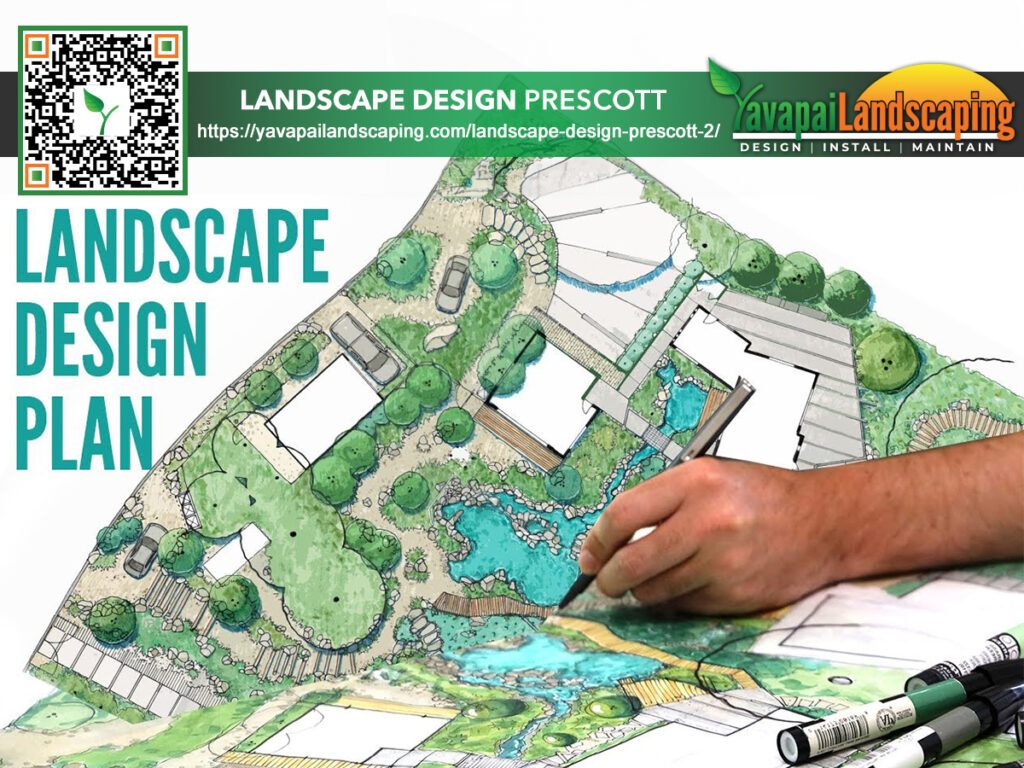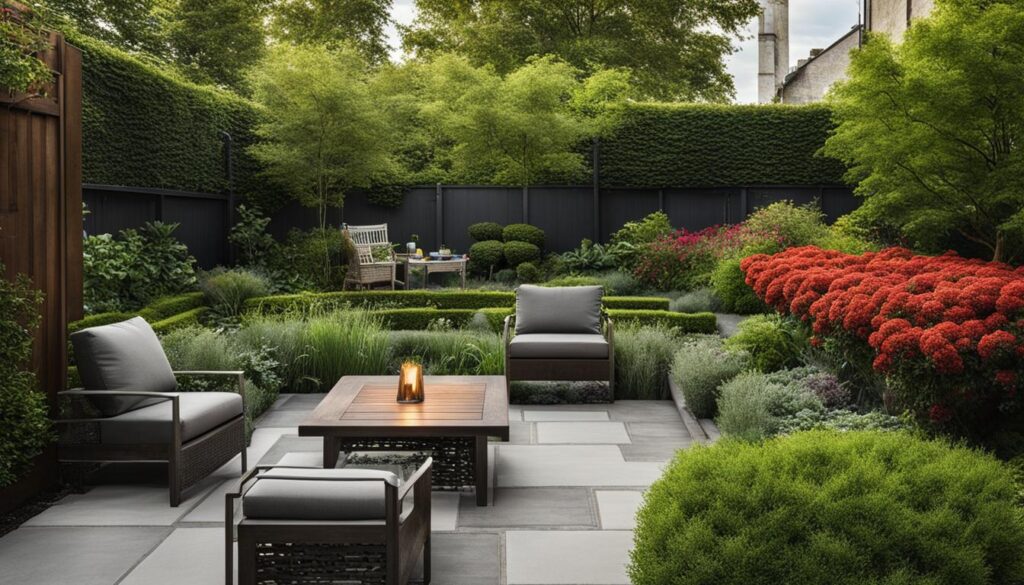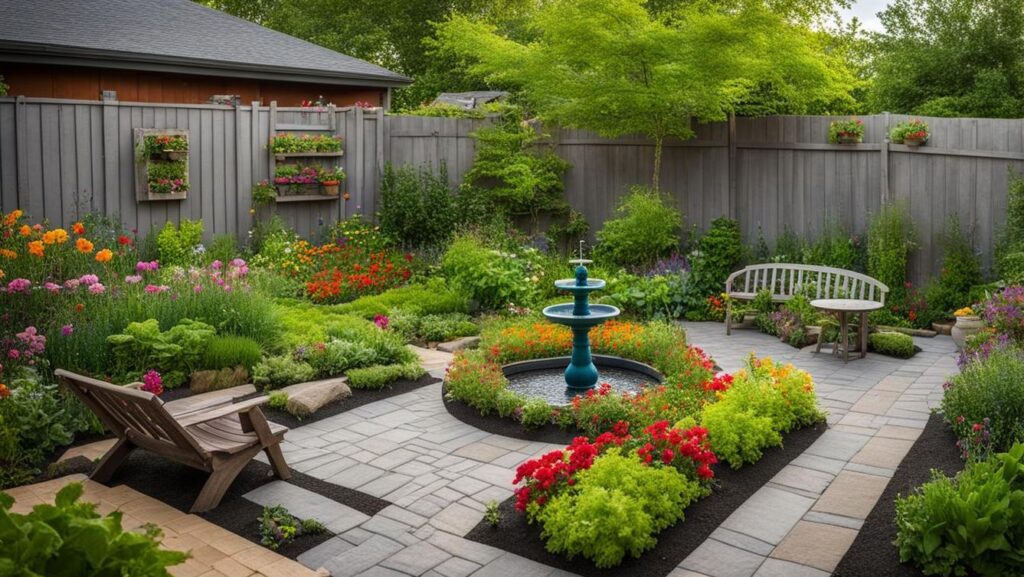
When it comes to landscape design for small urban gardens, there are key principles that can help create beautiful and functional outdoor spaces in Prescott, AZ. These principles take into account the limited space available and focus on maximizing the potential of small garden areas. By understanding and applying these principles, you can transform your small urban garden into a stunning oasis that is both visually appealing and practical.
Key Takeaways:
- Flexible and practical design solutions are crucial for small urban gardens.
- Architectural structures can create a sense of enclosure in small garden spaces.
- Harmony in color and material selection enhances the overall aesthetic.
- Working with the natural surroundings brings a sense of cohesion to the design.
- Proportion and scale play a vital role in small garden design.
Make Your Small Garden A Multitasking Space Wonder
A well-designed small garden can be a multitasking sanctuary that offers both sensorial and practical functionality. By incorporating flexible design solutions, you can create a space that adapts to various needs, providing different experiences throughout the day, season, and year. Elegant and classic design elements combined with practicality will ensure that your small garden is both beautiful and functional, maximizing its potential.
One key aspect of a multitasking garden is its ability to engage the senses. Consider incorporating fragrant flowers and herbs to delight the sense of smell, creating a soothing and inviting atmosphere. Incorporate a variety of textures through different plant choices, such as soft ferns, velvety lamb’s ear, or spiky succulents, to engage the sense of touch. The careful selection of plants that bloom at different times will ensure that your garden is visually captivating throughout the year.
Practical functionality is another crucial element in a small garden. Think about the different activities you’d like to enjoy in your outdoor space. By creating designated areas for dining, lounging, or gardening, you can maximize the usability of your garden. Consider versatile furniture pieces that can serve multiple purposes, such as benches with hidden storage or tables that can be easily folded away when not in use. Utilizing vertical space, such as vertical gardens or hanging planters, can also help maximize the functionality of your small garden.
| Benefits of a Multitasking Garden | Examples |
|---|---|
| Maximizes usability of limited space | Combining a dining area with a vegetable garden |
| Offers a variety of sensory experiences | Planting fragrant flowers and herbs |
| Provides opportunities for relaxation and recreation | Creating a cozy reading nook or yoga corner |
| Enhances the visual appeal of the garden | Integrating different textures and colors |
In summary, a multitasking small garden is achieved through a combination of flexible design, sensorial engagement, and practical functionality. By carefully selecting plants, incorporating various textures, and creating designated areas for different activities, you can transform your small garden into a versatile and enchanting space that adapts to your needs and provides year-round enjoyment.
Lead The Eye In A Space Surrounded By Man-Made Structures
When designing a small garden in an urban environment filled with man-made structures, it is crucial to consider the garden as a narrative. By intentionally shaping the visual experience and directing the observer’s gaze, you can create a sense of simplicity and harmony within the space. Strongly defined architectural elements can enhance the beauty of the garden while providing organization and order in a limited area.
Man-made structures such as walls, fences, pergolas, or trellises can serve as focal points within the garden. These structures not only add visual interest but also act as guides, leading the eye from one area to another. For example, a tall trellis covered in climbing plants can create a sense of scale and verticality, drawing attention upward and making the garden appear larger.
Additionally, the use of pathways and stepping stones can create a visual journey through the space. By strategically placing these elements, you can lead visitors from one point of interest to another, ensuring they experience the garden deliberately and engagingly.
As simplicity is key in an urban environment, it is important to avoid clutter and keep the design clean and streamlined. Choose a limited color palette and focus on using natural materials such as stone, wood, or metal to create a cohesive and harmonious look. By consciously leading the eye and creating a sense of order, a small garden surrounded by man-made structures can become an oasis of tranquility during urban chaos.
Table: Architectural Elements in Small Gardens
| Architectural Element | Function | Examples |
|---|---|---|
| Trellises and pergolas | Provide verticality, act as visual guides | Wooden trellis covered in climbing plants, metal pergola with fabric canopy |
| Walls and fences | Define boundaries, create privacy | Stone wall, bamboo fence |
| Pathways and stepping stones | Lead the eye, create a visual journey | Gravel pathway, stepping stones through a grassy area |
Create Harmony For A Unified Aesthetic
When designing a small urban garden, achieving a harmonious and unified aesthetic is essential in Prescott, AZ. The careful editing of elements is crucial to avoid overwhelming the space. By selecting a neutral palette for the overall structure and utilizing natural materials, you can create a visually cohesive and timeless garden design.
One of the key editing choices in harmonious garden design is the selection of colors. Using a neutral palette for the hardscape elements such as paths, walls, and seating areas provides a solid foundation for the overall design. Neutral colors like shades of gray, beige, or white create a sense of unity and allow the plants to take center stage, adding pops of color throughout the garden.

Another important aspect of creating a unified aesthetic is the use of natural materials. Incorporating materials such as wood, limestone, and granite adds warmth, texture, and a touch of elegance to the garden. These natural elements help to create a seamless connection between the outdoor space and its surroundings, enhancing the overall harmony of the design.
Table: Materials for a Harmonious Garden Design
| Material | Description |
|---|---|
| Wood | Provides warmth and natural beauty, ideal for decking, seating, and raised beds. |
| Limestone | Offers a classic and timeless look, perfect for paving and retaining walls. |
| Granite | Provides durability and versatility, suitable for paths, steps, and water features. |
In addition to color and materials, maintaining a sense of simplicity and balance is crucial in a harmonious garden design. Avoiding clutter and overcrowding of elements is key. Each element should have its space and purpose, contributing to the overall cohesiveness of the garden.
By carefully considering the editing choices, selecting a neutral palette, and incorporating natural materials, you can create a harmonious and visually pleasing small urban garden. The unity and balance achieved through these choices will create a tranquil and inviting outdoor space.
Working with the Space You Have – And the Natural Surroundings
To design a small garden that is both visually appealing and harmonious with its surroundings, it’s important to work with the space you have and consider the existing characteristics of the area. By understanding the unique features of the site, such as views, thriving plants, and focal points, you can create a garden that feels connected to its environment.
One way to work with the space is to consider the natural surroundings when selecting plants for your garden. Native plants are well-adapted to the local climate and soil conditions, making them more likely to thrive. They also provide habitat and food for local wildlife, helping to create a balanced ecosystem within your garden.
Finding focal points within the space can also help guide your design choices. Whether it’s a stunning tree, a beautiful view, or a piece of artwork, focal points draw the eye and create a sense of visual interest. By strategically placing plants and other garden elements around these focal points, you can create a harmonious and balanced composition.
Working with the space you have and considering the natural surroundings will not only enhance the overall aesthetic of your small garden but also create a connection to the larger environment. By incorporating native plants and highlighting existing focal points, you can design a garden that feels unique, inviting, and in harmony with nature.
Table: Selection of Native Plants
| Plant | Characteristics | Benefits |
|---|---|---|
| Lavender | Drought-tolerant, aromatic leaves | Attracts pollinators, adds fragrance |
| California Poppy | Bright orange or yellow flowers | Adapts well to arid conditions, adds color |
| Manzanita | Evergreen shrub with reddish-brown bark | Provides habitat for birds, adds texture |
| Coastal Sagebrush | Silvery-gray foliage, drought-tolerant | Attracts butterflies, adds texture |
| Coffeeberry | Shiny, dark-green leaves | Provides food for birds, attracts wildlife |
Perfect Your Proportions
Proportion and scale play a crucial role in the design of small gardens. Getting the sizing right is essential to create a harmonious and visually appealing space. While it may be tempting to fill every inch of your garden with plants and furniture, it’s important to avoid overcrowding. Too many small elements can make the garden appear cluttered, while oversized elements can make it feel cramped.
To achieve balanced proportions, research the size and spacing requirements of the plants you choose. Consider how they will grow and fill the space over time. Additionally, when selecting furniture, opt for pieces that are appropriately sized for the area. Using tape to plan the layout of furniture before making purchases can help you visualize how different pieces will fit together and prevent design disasters.
By paying careful attention to proportion and scale, you can create a well-balanced and visually pleasing small garden that feels open and inviting. Get to know more about What Is the Future of Sustainable Landscape Architecture?
Choosing the Right Plant Sizes
When it comes to planting in a small garden, selecting the right sizes for your plants is crucial. Choosing the wrong-sized plants can result in an uneven and disjointed appearance. Opt for a combination of small, medium, and large plants to create depth and visual interest. Ensure that the mature size of each plant is appropriate for the available space, allowing room for growth without overpowering the garden.
Considerations for Furniture Selection
Just as with plants, choosing the right-sized furniture is essential for proper proportioning in a small garden. Oversized furniture can make the space feel cramped and overwhelming, while furniture that is too small may seem insignificant and out of place. Look for compact pieces that are proportional to the area and consider multifunctional options that can serve multiple purposes. Additionally, opt for furniture with a lightweight and airy design to create an open and spacious feel.
Table: Proportion and Scale Guidelines for Small Gardens
| Element | Guidelines |
|---|---|
| Plants | Choose a mix of small, medium, and large plants to create balance and depth. Ensure the mature size is appropriate for the available space. |
| Furniture | Select compact furniture that is proportional to the garden. Opt for lightweight designs to create an open and spacious feel. |
| Layout | Use tape to plan the layout of furniture before making purchases. Consider how different pieces will fit together and ensure proper spacing. |
Follow the Regulating Line

Regulating lines is an essential design concept that can bring harmony and order to any landscape. These imaginary lines, based on principles of geometry, help organize elements within a small garden and create a sense of unity. By establishing regulating lines using prominent features like property boundaries, buildings, or existing trees, you can guide the placement of various design elements and create a cohesive visual experience.
When working with regulating lines, it’s important to consider the flow of movement within the garden. By aligning paths, borders, and architectural structures along these lines, you can create a sense of direction and purpose. This not only enhances the visual appeal of the garden but also ensures a logical and intuitive layout that is pleasing to the eye.
Additionally, regulating lines can help establish proportion and scale within a small garden. By adhering to the natural geometry of these lines, you can achieve a balanced and harmonious design. The golden ratio is often used as a guide for determining the ideal proportions of various elements within the garden, further enhancing the overall aesthetic.
The Benefits of Following Regulating Lines:
- Creates a sense of order and structure
- Enhances the overall visual appeal
- Guides the placement of design elements
- Establishes proportion and scale
- Improves the flow of movement within the garden
Incorporating regulating lines into your small garden design can bring a sense of harmony and order, transforming your outdoor space into a visually stunning oasis. By carefully aligning paths, structures, and elements along these lines, you can create a cohesive and balanced design that is both pleasing to the eye and functional.
Conclusion
In conclusion, designing a small urban garden requires a thoughtful approach and adherence to key landscape design principles. By incorporating flexibility, harmony, proportion, and scale, you can create a visually appealing and functional outdoor space.
Yavapai Landscaping Prescott offers free quotations for Prescott and its nearby localities for landscaping and tree services. These include tree removal, trimming, stump grinding, land clearance, storm clean up, irrigation, and emergency tree service.
FAQ
What are the key principles of landscape design for small urban gardens?
The key principles of landscape design for small urban gardens include flexibility, practicality, harmony, working with the natural surroundings, and proportion and scale. These principles help create a visually appealing and functional outdoor space.
How can I make my small garden a multitasking space?
To make your small garden a multitasking space, focus on flexible design solutions that can accommodate various functions. Consider sensorial and practical purposes, and aim to offer different experiences throughout the day, season, and year.
How can I create a sense of simplicity and harmony in my small garden surrounded by man-made structures?
To create a sense of simplicity and harmony in a small garden surrounded by man-made structures, consider what people want to see and feel as they move through the garden. Shape the narrative of the space and use strongly defined architectural structures to accentuate the beauty of the garden while providing organization and order.
How can I achieve a harmonious and unified aesthetic in my small garden?
Achieving a harmonious and unified aesthetic in a small garden involves careful editing of elements. Select a neutral palette for the overall structure and allow plants to provide color. Choose natural materials such as wood, limestone, and granite for surfaces and decor to add a timeless and elegant touch.
How can I work with the space I have and the natural surroundings in my small garden?
When working with a small garden, consider the existing characteristics such as views, thriving plants, and focal points. Use these features to guide the design process. Additionally, choose hardy plants that thrive in the specific site conditions and create a garden that feels connected to its environment.
